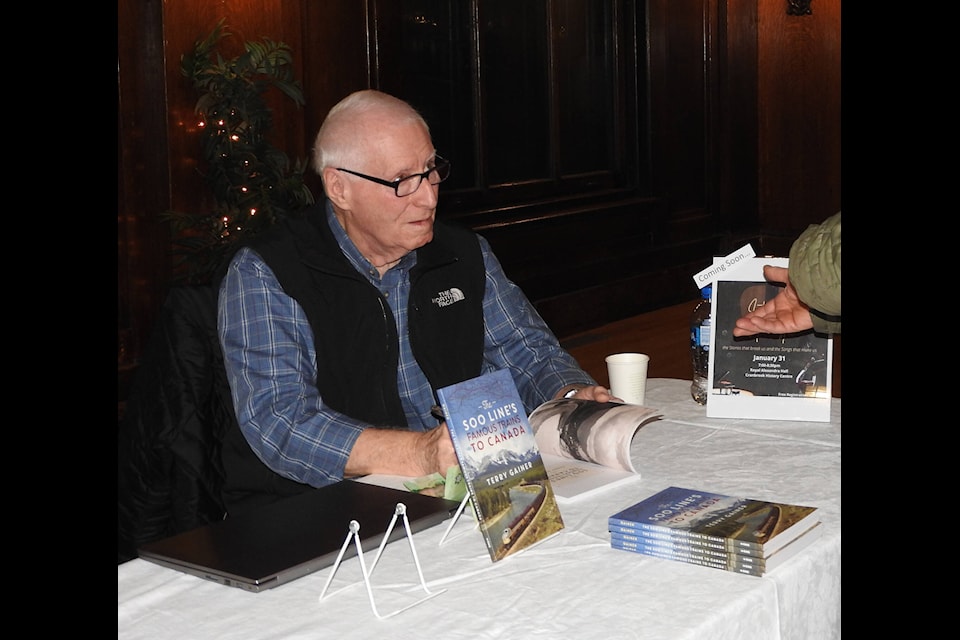Authors Keith Powell and Terry Gainer held book signings at the Cranbrook History Centre on Nov. 22 for their latest works, which document important history in the Kootenays.
Powell’s book, Koocanusa Burning, examines the trials and triumphs that arose in the Southeast Kootenays and Northern Montana after the Libby Dam was built in 1975. Gainer’s novel, The Soo Line’s Famous Trains to Canada, is the third book in a series about the creation of the Soo railway line, which spanned the Great Lakes to the Pacific Coast. It delves into the history of famous tourist trains that crossed the Canada-U.S border, carrying sightseers to the Rockies.
Koocanusa Burning
The Libby Dam, which opened on August, 24, 1975 in Libby, Montana, left a lasting legacy on the land along the Kootenay River. The dam brought money into the area through power generation, however the clearing of land in preparation for the dam, and the flooding of the Koocanusa Reservoir, adversely impacted Indigenous cultural values and displaced farmers and ranchers.
Powell writes about the farm and ranch lands that were burned in order to clear space for the dam. Some of the most fertile agricultural land in the area was destroyed, and thriving farm towns like Waldo, Krag, Warland and Rexford completely disappeared.
“They basically stripped the valley right down to bedrock …” said Powell. ” Farmers and ranchers tried to protest, tried to negotiate a better deal, but the government wasn’t too receptive at that point in time.”
“If you go and talk to many of the families today, there are still bitter feelings about the way that was handled,” he added.
Still, the creation of the dam wasn’t a complete loss. The government negotiated an agreement that would see millions of dollars generated from the dam flow back into the Canadian economy. Columbia Basin Trust was born from this historic accord — to manage a one-time endowment for the benefit of people and communities in the Columbia Basin, the region most affected by the dam.
Powell has a personal connection to this piece of history. He grew up in Jaffray in the late 60s and early 70s, and went to school with the children of the families that were being displaced by the dam.
“It had a devastating impact for a lot of those kids and they’d come to school pretty upset because they didn’t know what their future held. All of a sudden, they were being uprooted and moved,” he recalled.
The impact of the Libby Dam on each of their families was unique, and some fared better than others.
“Some of them, it affected them for the rest of their life. It’s been a long-lasting legacy for them…” he said. “[Others] they were pretty resilient. Many of them resettled and reestablished their life and got on with things.
Ultimately, Koocanusa Burning is a story about the people, places and events that played a role in and were impacted by the creation of the dam. Powell uses both fictional and non-fictional characters to help tell it.
“I try to take as many of the facts as I can and build a story around it,” he said.
“It’s part of our history. There’s never enough information about the Kootenays, so any time we can remember the past, I think that’s good.”
The Soo Line’s Famous Trains to Canada
Gainer’s book provides a history of the trains that operated along the Soo Line and how they put the Rocky Mountains and other areas in the west on the map as tourism destinations.
“Back then, Spokane, the big city in the northwest, was a distant dream for people living here,” he said. “Unless you wanted to ride a horse, you weren’t going there. “All of a sudden, the railway came through here and they started this [Soo Spokane] train and now Spokane was half a day away. This got people down to Spokane where there was more shopping, where there was bigger cities, more stores, much cheaper prices, better merchandise.”
The Soo Spokane Train ran through Cranbrook and some of its cars on display at the Cranbrook History Centre.
Passenger trains have been Terry Gainer’s life-long passion. His father was an agent at the Canadian Pacific Station in Banff and his family lived above the train platform. As a child, he enjoyed sitting on their balcony and watching the bustling people and noisy locomotives. He often met Americans, Europeans and Australians travellers and he didn’t realize how much of a tourism centre the area was until he moved away in later years.
“I watched people getting on and off these trains. I played in the train yards there and I got to know a lot of the summer staff cause there was all these extra tourist trains coming through Banff. That was my backyard…” he said. ” I think my love of travel and trains began because I grew up in that atmosphere.
The Soo Line was created by a group of millers in Minneapolis in the 1880s who wanted to get their flour to the Atlantic Coast without paying hefty shipping fees.
“They felt they were being overcharged by the Chicago railways to get their flour to the Atlantic ports and if you couldn’t get your flour to the market, it wasn’t worth anything,” he explained. “They built their own railroad up to Canada, and in agreement with Canadian Pacific, ran on their line to Montreal. Then [they had] an agreement with a third line to run down to Boston. Then they started a passenger service.”
Mining operations brought the line further west.
“Back in those days, the Kootenays was the economic engine for the entire province. This was a really wealthy area at that time …” he said. “The mines were discovered. That attracted the railways, that attracted the people, which built the community.”
